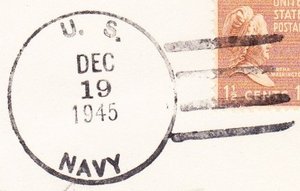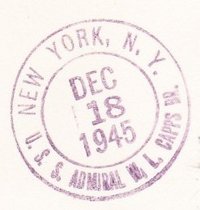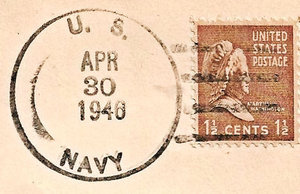ADMIRAL W L CAPPS AP 121
Ship Name and Designation History
This section lists the names and designations that the ship had during its lifetime. The list is in chronological order.
Keel Laid December 15 1942 - Launched February 20 1944 Acquired by U.S. Navy from Maritime Commission September 18 1944 Struck from Naval Register May 21 1946 Returned to Maritime Commission Transferred to U.S. Army Transportation Service Reacquired by U.S. Navy March 1 1950 Transferred to Military Sea Transportation Service (MSTS) Struck from Naval Register October 9 1969 Laid up in National Defense Reserve Fleet Reacquired and reinstated in Naval Register November 1 1978 Placed In Service as Barracks Hulk Laid up at Pearl Harbor, HI (Date unknown) Struck from Naval Register October 25 1993 Sunk June 16 2000 during RIMPAC 2000 EXERCISE as a missile target |
Naval Covers
This section lists active links to the pages displaying covers associated with the ship. There should be a separate set of pages for each name of the ship (for example, Bushnell AG-32 / Sumner AGS-5 are different names for the same ship so there should be one set of pages for Bushnell and one set for Sumner). Covers should be presented in chronological order (or as best as can be determined).
Since a ship may have many covers, they may be split among many pages so it doesn't take forever for the pages to load. Each page link should be accompanied by a date range for covers on that page.
- USS ADMIRAL W. L. CAPPS Covers Page 1 (1945-46)
- USNS GENERAL HUGH J. GAFFEY Covers Page 1 (1953-63)
Postmarks
This section lists examples of the postmarks used by the ship. There should be a separate set of postmarks for each incarnation of the ship (ie, for each entry in the "Ship Name and Designation History" section). Within each set, the postmarks should be listed in order of their classification type. If more than one postmark has the same classification, then they should be further sorted by date of earliest known usage.
A postmark should not be included unless accompanied by a close-up image and/or an
image of a cover showing that postmark. Date ranges MUST be based ONLY ON COVERS IN
THE MUSEUM and are expected to change as more covers are added.
>>> If you have a better example for any of the postmarks, please feel free to replace the
existing example.
|
Postmark Type |
Date From to Date To |
Thumbnail Link To Postmark Image |
Thumbnail Link To Cover Image |
|---|
Post Office Established September 1 1944 - Disestablished April 30 1946
|
Locy Type |
1945-12-18
|
 |
 |
Note:
|
Locy Type |
1945-12-18
|
 |
 |
Note:
|
Locy Type |
1946-04-30 |
 |
 |
Last Day of Postal Service, cachet by Tazewell G. Nicholson
Other Information
ADMIRAL W.L. CAPPS earned the American Campaign Medal, the Europe-Africa-Middle East Campaign Medal, the Asiatic-Pacific Campaign Medal, the World War II Victory Medal and the Navy Occupation Service Medal (with Asia clasp) during her Naval career.
NAMESAKE - Washington Lee Capps (January 31 1864 - May 31 1935)
Capps was appointed to the Naval Academy in 1880. Upon graduation, he served in the screw frigate TENNESSEE for the two years sea duty then customary prior to commissioning. After becoming an Ensign in 1886, Capps studied naval architecture at the University of Glasgow in Scotland. After returning to the United States in 1888 and brief duty at the Navy Department, he was assigned to Cramp's shipyard in Philadelphia. Capps moved to the New York Navy Yard in 1889 and remained there joining the Bureau of Construction and Repair in 1892. Three years later he became the superintending constructor at the Union Iron Works in San Francisco. There, he supervised the construction of USS OREGON BB-3, USS WISCONSIN BB-9, FARRAGUT Torpedo Boat No. 11, USS MARIETTA PG-15, and USS WHEELING PG-14. Later attached to the staff of Rear Admiral Dewey, commander of the Asiatic Squadron, he was present during the Battle of Manila Bay. After the capture of Manila, he had three of the Spanish warships salvaged and repaired. Next Capps spent two years with the Board of Inspection Survey, followed by a tour of duty as the Head, Construction and Repair Department at the New York Navy Yard. In 1903, he became the Constructor of the Navy and Chief of the Bureau of Construction and Repair with the rank of rear admiral. During his tenure as Constructor of the Navy, numerous new ideas in warship design were tested and adopted. Notable among his innovations was the decision to mount the main batteries of battleships on the centerline, thereby increasing their broadside weight of metal to the maximum. During his tenure, Rear Admiral Capps served on a number of American and international committees which had been established for such purposes—among others—as improving the organization of the Navy and adopting new safety measures at sea to prevent a recurrence of disasters such as the sinking of the Titanic in April 1912. During World War I, he was senior member of the Navy's Compensation Board which oversaw the cost aspect of the Navy's expanded ship acquisition program. He was also general manager of the United States Shipping Board's Emergency Fleet Corp. Forced by poor health to relinquish these duties for a time, Capps returned to his position on the Compensation Board, became the senior member of the Naval War Claims Board, and served on other boards and committees. Although placed on the retired list effective January 31 1928, Rear Admiral Capps continued on active duty until the day of his death at Washington, D.C., on May 31 1935
USAT GENERAL HUGH J. GAFFEY earned two National Defense Service Medals, the Korean Service Medal, the Vietnam Service Medal (w/ 1 Campaign star). the United Nations Service Medal, the Republic of Vietnam Campaign Medal and the Republic of Korea War Service Medal during her USAT career.
NAMESAKE - Hugh Joseph Gaffey (November 18 1895 – June 1946)
Gaffey was Chief of Staff for General George Patton's Third Army during World War II. He attended Officers Training School at Fort Niagara, New York State, and was commissioned as a Second Lieutenant in the Field Artillery Reserve on August 15 1917. Assigned to the 312th Field Artillery at Fort Meade, Maryland, he went to Europe in August 1918 and served in France and Germany before returning to the United States in August 1919. During the next two decades he served at various posts in the United States and served with the 15th and 18th Field Artillery and the 7th Cavalry Brigade. Assigned to the I Armored Corps in July 1940, he served with them until July 1942 when he was assigned to the 2nd Armored Division. Appointed Brigadier General August 5 1942, he was sent to the European Theater in November; and, in April 1944, he was designated Chief of Staff for General Patton's 3d Army fighting in France. He then assumed command of the 4th Armored Division in December. Major General Gaffey was killed in a B-25 Mitchell crash at Godman Field, Kentucky
If you have images or information to add to this page, then either contact the Curator or edit this page yourself and add it. See Editing Ship Pages for detailed information on editing this page.
Copyright 2025 Naval Cover Museum